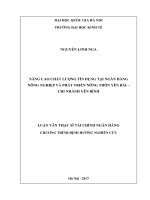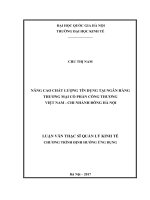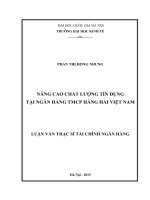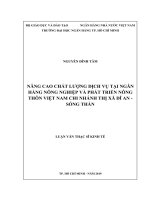Luận văn thạc sĩ NÂNG CAO CHẤT LƯỢNG bán lẻ tại NGÂN HÀNG BIDV CHI NHÁNH NAM hà nội en
Bạn đang xem bản rút gọn của tài liệu. Xem và tải ngay bản đầy đủ của tài liệu tại đây (801.89 KB, 101 trang )
THESIS
INTERNATIONAL BUSINESS MANAGEMENT
THESIS
"IMPROVING THE QUALITY OF RETAIL BANKING SERVICES IN
BANK FOR INVESTMENT AND DEVELOPMENT OF VIETNAM - HANOI
BRANCH SOUTH"
ACKNOWLEDMENT
First, I would like to say my sincere thank to our teachers in the Paris
Graduate School of Management who have equipped me with valuable knowledge
in the past.
I would like I would like to express my sincere thanks to the Doctor Nguyen
Thanh Hieu, who has enthusiastically instructed me to complete the thesis.
After all, I would like to send many thanks to my friends, my colleages and
my closed people who did not hesitate to spend time on support, give comments and
help me during my study time.
I want to express my sincere thanks to all of you
i
DECLARATION
I declare that the Thesis for Master of Business Administration "Improving
the quality of retail banking services in Bank for Investment and Development
of Vietnam - Hanoi Branch South" has been conducted by myself, which is
reliable with clear information source written by the subjective view. I'm solely
responsible for the accuracy from the reference materials.
ii
TABLE OF CONTENS
ACKNOWLEDMENT................................................................................................i
DECLARATION........................................................................................................ii
TABLE OF CONTENS ............................................................................................iii
LIST OF TABLES AND FIGURES..........................................................................vi
INTRODUCTION......................................................................................................1
CHAPTER 1: THEORETICAL BASES ON RETAIL BANKING SERVICE
QUALITY.................................................................................................................... 4
1.1 General view on retail banking services..............................................................4
1.1.1 Definition of retail banking services.............................................................4
1.1.2 Characteristics of retail banking services......................................................5
1.1.3 Roles of retail banking services....................................................................6
1.1.3.1 For the economy....................................................................................6
1.1.3.2 For the bank...........................................................................................6
1.1.3.3 For the customers...................................................................................6
1.1.4 Retail banking services.................................................................................6
1.1.4.1 Capital mobilization...............................................................................6
1.1.4.2 Credit service.........................................................................................7
1.1.4.3 Card service...........................................................................................7
1.1.4.4 Payment services....................................................................................8
1.1.4.5 Electronic banking services....................................................................8
1.1.4.6 Other banking services...........................................................................9
1.2 Basic quality issues of retail banking service......................................................9
1.2.1 Service quality concept.................................................................................9
1.2.2 Relationship between service quality and customer satisfaction.................12
1.2.3 The evaluation theory of the service quality...............................................13
1.2.4 Retail banking services quality...................................................................17
1.2.5 Measuring the services quality of retail banking.........................................18
1.2.6 The need to improve retail banking services quality...................................19
1.3 Experience of improving retail banking services quality of a number of
banks in the world and lessons for commercial banks in Vietnam..........................20
iii
1.3.1 Experience of improving retail banking services quality............................20
1.3.2 Lessons on improving retail banking service quality for commercial
banks in Vietnam.................................................................................................23
CHAPTER II: THE CURRENT SITUATION ON SERVICE QUALITY OF
RETAIL BANK AT BANK FOR INVESTMENT AND DEVELOPMENT OF
VIET NAM – HA NOI SOUTH BRANCH.............................................................25
2.1 About Bank for Investment and Development of Viêt Nam – Ha Noi South Branch
................................................................................................................................ 25
2.2 Results of business operations of Retail banking at Ha Noi South BIDV.........26
2.2.1 Capital mobilazation...................................................................................26
2.2.2 Credit..........................................................................................................28
2.2.3 Other services.............................................................................................30
2.2.4 Business results...........................................................................................31
2.3 Analyse, evaluate the actual situation of service quality of the retail banking
through business results of retail banking at the Bank for Investment and
Development of Vietnam - Hanoi South Branch.....................................................31
2.3.1 The quality of retail capital mobilization service........................................31
2.3.2 The quality of retail credit service..............................................................35
2.3.3 Quality of other service:.............................................................................38
2.3.3.1 Quality of card service:........................................................................38
2.3.3.2 Quality of payment service..................................................................42
2.3.3.3 The quality of electronic banking.........................................................44
2.4 The main factors affecting the quality of retail banking services at the Bank
for Investment and Development of Vietnam – South Hanoi Branch......................46
2.4.1 Reliability...................................................................................................46
2.4.2 Responsiveness...........................................................................................46
2.4.3 Tangibles.....................................................................................................47
2.4.4 Assurance....................................................................................................47
2.4.5 Empathy......................................................................................................48
2.5 Assessment of retailing service quality at Bank for Investment and
Development of Vietnam at South Hanoi Branch based on the comment of
iv
customer.................................................................................................................. 49
2.6 Review of retailing service quality of BIDV at South Hanoi Branch after
investigation and analysis........................................................................................54
2.6.1 Achievements in the Quality of Retail Banking Services...........................54
2.6.2 Restrictions on the quality of retail banking services..................................56
2.6.3 The cause of the limitation..........................................................................56
CHAPTER III: SOLUTIONS FOR SERVICE QUALITY IMPROVEMENT
IN
RETAIL
BANKING
OF
BANK
FOR
INVESTMENT
AND
DEVELOPMENT OF VIETNAM –HA NOI SOUTH BRANCH.........................58
3.1 The development orientation of Bank for Investment and Development of
Vietnam - South Hanoi Branch in the near future....................................................58
3.1.1 The general development Orientation.........................................................58
3.1.2 The development of retail banking services................................................59
3.2 Several Solutions for Retail Banking Service Quality Improvement.................60
3.2.1 Improving the quality of infrastructure.......................................................60
3.2.2 Solutions to improve the quality of human resources.................................62
3.2.3 Solutions to improve the quality of organizational management of
services systems retail banking............................................................................64
3.2.4 Solutions of developing new retail services................................................69
3.2.5 Designing service quality standards............................................................70
3.3 Suggesting to the State Bank and Government Offices.....................................71
CONCLUSION.........................................................................................................73
REFERENCES.........................................................................................................74
APPENDIX ............................................................................................................... 76
v
LIST OF TABLES AND FIGURES
TABLES
Table 2.1:
Table 2.2:
Table 2.3:
Table 2.5:
Table 2.6:
Table 2.7:
Table 2.8:
Table 2.9:
Table 2.10:
Table 2.11:
Table 2.12:
Table 2.13:
Table 2.14:
Table 2.15:
Table 2.16:
Table 2.17:
Table 2.18:
Table 2.19:
Table 2.20:
Table 2.21:
The Situation of capital mobilization of Ha Noi South BIDV, 2007
-2011 stage.............................................................................................27
The Situation of credit activities of Ha Noi South BIDV, 2007
-2011 stage............................................................................................29
Business results of Ha Noi South BIDV, 2007 -2011 stage....................31
Expense for interests from mobilizing population’s capital of Noi
South BIDV............................................................................................34
Scale of individual lending service of Ha Noi South BIDV...................36
The quality of retail credit of Hanoi south BIDV...................................37
Card sales of Ha Noi South BIDV in 2007 2011 stage...........................38
Number of new card issuance of Ha Noi South BIDV during 2007
-2011 stage.............................................................................................39
Number of ATM, POS of Ha noi south BIDV during 2007 – 2011 stage
................................................................................................................ 40
Comparison oF property between domestic debit cards among banks
................................................................................................................ 41
Number of payment transaction of individuals at Ha Noi south BIDV
................................................................................................................ 42
Money transfer sales of individuals at Ha noi south BIDV....................43
Average time to deal with payment transaction of individual at Ha
noi south BIDV......................................................................................44
Number of customers using modern services oF Ha Noi south BIDV
................................................................................................................ 45
Data encryption......................................................................................49
Classifying survey..................................................................................50
Result of descriptive survey analysis......................................................50
Result of testing Cronbach’alpha............................................................51
Summary of the coefficient on the conformity of model........................52
Result of linear regression analysis........................................................53
FIGURES
vi
Figure 1.1: Model of five service quality gap...........................................................13
Figure 1.2:
The theoretical study model..............................................................................16
vii
INTRODUCTION
1. THE THESIS SIGNIFICANE
The international economic integration has opened up many opportunities,
but it also places many challenges to the banking service suppliers because they
have to compete severely with foreign banks who are not only powerful on the
financial potential but much experienced about modern banking service
development.
Under the competition pressure on banking service supply and the fast IT
development, the year 2010 and 2011 is evaluated to be a “booming year” on retail
banking service with increased approaches to the individual customers and small
and medium enterprises.
According to the estimate, the Vietnam population will increase by 90
million people in 2012 with the increasing income for people. It is the potential
market for the commercial banks, when aiming at the payment not by cash.
Therefore, the retail bank development strategy of BIDV- the South Hanoi Vietnam
will focus specially on individual customers with various retail products which are
professional and suitable to the demand and capacity of each different objects and
customer segments.
With the aim of building the retail banking service system of high quality,
safety with high economic effectiveness on the base of enhancement of international
economic integration, retail banking service market expansion by through the
bilateral and multilateral management, application of advance banking technology
and suitable development of distribution system to provide sufficiently, timely and
conveniently retail service products and utilities for all customers.
With the continuously changing trend of consumption according to the life
demand, BIDV- Southern Hanoi Branch must build new strategy and solution to
become a multi-functional retail bank. For meeting the increasing banking demand
in the severe competition among banks, BIDV-Southern Hanoi Branch is trying to
extend the business net, increasing the retail banking service with the improved
1
service style “customers are God”, step by step increasing the reputation and brand
name of BIDV in general and BIDV-Southern Hanoi Branch in particular in the
financial market.
From the above fact, the quality re-evaluation of the retail banking service
quality of BIDV- Southern Hanoi Branch as well as supporting banks in building
solutions for enhancing the retail services during the incoming time in order to
increase the satisfaction of customer is very important, so I have considered and
selected the thesis subject “Improving the quality of retail banking services in
Bank for Investment and Development of Vietnam - Hanoi Branch South" The
subject is conducted for the above objectives and hopefully the author will receive
contribution ideas to complete the subject matter.
2. STUDY SUBJECTIVES:
- Evaluate the real situation of the retail banking service quality of BIDV- Southern
Hanoi Branch.
- Suggest some solutions for increasing the retail banking service quality of BIDVSouthern Hanoi Branch. The main objective focuses on the Credit and Capital
mobilization.
3. SUBJECT, METHOD AND RESEARCH SCOPE
- Research: The quality of retail banking services in BIDV- Southern Hanoi Branch.
- Research methodology: Analyze main factors affecting the quality of retail
banking services at BIDV- Southern Hanoi Branch, after that conducting the
analysis of the customer satisfaction through practical survey, then proposing the
solutions for increasing the retail banking service quality.
-Scope of study: The research data is to 31/12/2011 in BIDV- Southern Hanoi Branch.
4. THE PRACTICAL MEANING OF THE RESEARCH SUBJECT:
Based on evaluation of retail banking service system in BIDV- Southern
Hanoi Branch, analyzing the achievements and failures in the retail banking system
quality, then propose the solutions for increasing the retail banking service system
in BIDV- Southern Hanoi Branch.
2
5. STRUCTURE OF THE RESEARCH SUBJECT:
Apart from the Introduction of the subject and the Conclusion, the research
subject is divided into 3 chapters with the detailed contents as below:
CHAPTER 1: Theoretical bases on retail banking service quality
CHAPTER II: The current situation on service quality of retail bank at bank
for investment and development of Viet Nam – Ha Noi South branch
CHAPTER III: Solutions for service quality improvement in retail banking of
bank for investment and development of VietNam – Ha Noi South branch
3
CHAPTER 1: THEORETICAL BASES ON RETAIL BANKING
SERVICE QUALITY
1.1 General view on retail banking services
1.1.1 Definition of retail banking services
In the open economy, the demand on banking services is increasingly high,
especially for the retail banking services. The targets of retail banking services are
individual customers, so the services are usually simple, easy for implementation
with focus on the services of deposit, account, debts, credit card registering and so
on. Depending on different ideas and research approaches, there are some concepts
on “retail banking services” being recognized as followed:
Retail market is a total new concept in the financial market, through which a
large number of individual laborers will approach the banking services, creating a
potential, variable and dynamic market. The terminology is Retail Banking- it
means that supplying services to the hand of end-users with quantity. It should be
understood that retailing is an activity of distribution, in which the researching,
promotion, study, experiment, discover and develop the modern distribution
channels- the outstanding feature is online business. The retailing includes three
main fields: market, distribution channels, services and service supply. Retailing is
more developed to be international.
According to economic experts in the Asian Institute of Technology-AIT,
retail banking service is to supply products, banking services to each individual,
small and medium enterprises through branches, customers who can approach
directly to products and banking services through telecommunication electronic
equipments and Information Technology.
According to the WTO, the retail banking is a typical service type of banks
where individual customers can make transactions in branches/ transaction offices
of banks to perform the services like: Deposit, account checking, mortgage, loan,
credit card service, debit card and related services.
4
According to the BIDV, retail banking services are the supply of products
mainly for individual customers with services like saving deposit, card services,
money transfer for abroad study, remittance services, electronic banking services,
individual consumption loans , business, etc. In short, retail banking services can be
fully understood as "retail banking services banking are services provided to the
individual or individuals, small and medium-sized businesses through a network of
branches or customers can directly access to the banking services through electronic
media and telecommunication "
1.1.2 Characteristics of retail banking services
- The served customer objects are variable from individuals, households and
small and medium enterprises.
- The retail banking services are variable but the value of each transaction is
not high so the risk level is low.
- The retail banking services require building a large number of various
distribution channels to supply services ton customers on wide region.
- The retail banking services base mostly on the modern IT background with
a professional staff team to extend and increase the product quality, bringing the
products to each individual customer.
- The service is simple and easy to implement: The target of retail banking
service is individual customers, so the services focus on deposit, payment, loan and
card services.
- The business development mainly bases on the brand name, quality of the
banking services, so the service quality is an important factor to develop the retail
banking services.
-The average operation cost is high. Although the number of customers is
high but they are in different place, so the transaction is not convenient. The bank
usually opens the network and invest into the online transaction with high cost.
- More various management ways which is more complicated because of the
wide customer network.
5
1.1.3 Roles of retail banking services.
1.1.3.1 For the economy
The retail banking services directly change the cash economy into the noncash economy, increasing the effectiveness of the state management, reducing the
social cost of payment and cash circulation, Beside, through retail banking services,
the money circulation process is enhanced with higher effectiveness, making use of
and exploiting the capital potential to promote the business and consumption,
increasing the people’s living standard.
1.1.3.2 For the bank
The retail banking services play an important role in diversifying the
products, extending the market, increasing the competition capacity, creating the
capital source for medium and long term for the banks to change the income
structure of banks, reducing the risks in banking business, at the same time
contributing to diversifying the banking activities, strengthening the national
finance.
1.1.3.3 For the customers
The retail banking services brings to the customers the conveniences, safety,
cost saving and effectiveness in the process of payment and income usage. In fact,
now the retail banking services have brought to banks a stable income with
decentralized risk, creating a steady base for the bank’s operation. Therefore,
commercial banks have initially considered the retail banking services as a core
activity for building, reinforce a stable customer network, then expand the business
to other sectors of the banks. Vietnam commercial banks have been developing,
increasing the retail banking services as a inevitable trend, consistent with the
common trend of banks in the region and in the world.
1.1.4 Retail banking services
1.1.4.1 Capital mobilization
One of important functions of Commercial banks is to mobilize capital for
giving loan and investment. Through methods and tools used, commercial banks
mobilizes capital from individual customers and small-medium sized enterprises
6
under the main forms such as non-term deposits, term deposits, valuable papers
(bills, bank bonds, etc.) and other forms of deposit. Each individual customer or a
small and medium enterprise has idle capital which is not great but with a large
number of customers, an abundant and potential source of capital will be created for
commercial banks. Currently, in addition to traditional deposit products, the
commercial banks have diversified more flexible savings product in term of terms
and interest rate in order to improve the quality of services to meet the needs of
customers .
1.1.4.2 Credit service
The retail credit services provide individual customers and small and
medium enterprises short-term, mid-term and long-term loans including loan for
abroad study, real estate, consumption, securities business, production and business,
overdraft loan, mortgage of valuable paper. The weight for lending individual
customers, small and medium enterprises are higher day by day in the total debt
balance of the banks, contributing to increasing sales and profit for commercial
banks. Loans to individual customers and small and medium companies brings a
great potential with non-stop development. However, the amount for one loan is
small and dispersed, so the management cost is high. Besides, customers are very
sensitive with the interest rate, term and procedure, so the commercial banks are
usually affected with competition factors in the market and the customer’s
profitability.
1.1.4.3 Card service
Bank card is a personal multi-functional financial products issued by the
banks with many utilities for customers. Cards can be used to withdrawing deposit,
sending deposit, issuing credit, payment or account transfer. Cards are used for
many non-financial services like account information inquires and so on. Many
kinds of different payment cards are available, but in general, there are two basic
types which are debit card (domestic and international) and credit cards. Debit cards
use the current balance of the account. While the credit cards are outstanding with
the feature of “purchasing first, payment later” based on the credit line issued by the
7
banks. The card services contribute an important part to the commercial banks in
capital mobilization, service charging and image PR. The card services go with the
technology application and the in interconnection among commercial banks for
market exploitation and IT infrastructure usage.
1.1.4.4 Payment services
The payment services are considered to be a profession component with high
profit rate but has not been paid proper attention. Payment means include cheque,
payment order, commercial bills, payment orders . Banks on behalf of customers
make payments for goods and services through the clearing, m online payment
transfer through the banking system within the banking system or other, transfer
within the country border or to the foreign countries.
Salary payment to the personal account, payment for electrical bills, water
bill, telephone bill and so on through the card services is developing and creating
substantial receiving source for commercial banks.
Money transfer services, money remittances are increasingly expanding and
developing. Many commercial banks have cooperated and been agents for money
transfer and remittance for a number of international financial institutions such as
Western Union, Money Gram ...
1.1.4.5 Electronic banking services
In the situation of integrated financial- banking market, Vietnam has
gradually opened door for foreign banks, services of domestic banks should be
distinctive in forms and contents. In which, the outstanding feature is the modern
banking services.
Currently, SMS Banking, eBanking, Mobile Banking and so on are services
selected by many customers. With this service, customers do not have to go banks
or spend much time on performing necessary transactions like account transfer,
account checking, payment, deposit and loan and so on. It is really an utility,
bringing customers to approach closely to the modern life. The application of
electronic banking services in business of current commercial banks is a
competitive advantage and it is one of important factors deciding the success in the
8
development trend of retail banking services in future. The modern electronic
service can be listed as follow:
Call center: The center provides information and explains all questions,
claims of customers. Currently, most of banks have Call center like 247/247 of
ACB, 24/7 of BIDV.
Phone banking: is a service, in which customers call to a fixed number of
the service providing banks for performing transactions or check accounts and
exchange rate, interest rate information.
Mobile banking: is a banking service through mobile phone. Customers
can check the balance, transaction; receive the balance information, interest rate
through SMS banking, payment for electricity, water, phone, internet and so on.
Home banking: is a kind of service in which transactions can be implemented
at home through computer system connected to the computer system of the banks
including money transfer, report, balance report, exchange rate, interest rate.
Internet banking: is a kind of banking services, in which customers
perform the transaction with banks through Internet. Customers can search
information about products, services of the banks or access information on personal
account, balance, deposit and loan.
1.1.4.6 Other banking services
Apart from the above services, services for individual customers include
collection/payment, money transfer for abroad study, valuable asset consignment,
safe lease and so on. The services for small and medium enterprises include
international settlement, foreign currency business, bond security.
1.2 Basic quality issues of retail banking service
1.2.1 Service quality concept
Service is a popular concept in marketing and business. It is a "special
products" with many different characteristics from other commodities such as
intangibility, heterogeneity, inseparability and can not be stored. Therefore, so far
there is no complete definition for service. According to VA Zeithaml and MJ Bitner
9
(2000), "Service is behaviors, process and method to do a certain work in order to
create value for customers to satisfy their needs and expectations"
Services play an increasingly important role in the national economy. Service
quality is one of the determining factors for the efficiency of services and creation
of value to contribute to the national economy.
Service quality is evaluated in connection with culture, job sector and field.
Therefore there are many different definitions for it. Depending on the object and
environment of research that understanding of service quality can serve as the basis
for implementing measures to improve it.
In development history, many service providers have found their differences from
rivals and keep customers through the implementation of excellent quality service.
Service quality has become a major marketing tool to differentiate competitors and
boost customer loyalty. Customers can only assess the quality after having
purchased and used a service. Therefore, the definition of service quality is often
subjective, largely based on the attitude, feeling and knowledge of service users.
After referring to materials, there is some concept of service quality that is used by
many writers.
Service quality is a measure of to what level a service has satisfied a
customer’s expectation. A quality service is one that meet the expectations of
customers in a consistent manner (Luu Van Nghiem, 2008, page 163) Gronroos
(1984) saw service quality in two aspects, one is technical quality (what is served)
and functional quality (how it is served). In the 1998 study, he described perceived
service quality is the difference between expectations and the service received.
Parasurman, Zeithaml and Berry (1985.1988) (cited from Nguyen Dinh Tho and
ctg.,2007) thought that "quality is the distance difference the real service and
products and the perceptions, feeling of customer when they use that products and
services”. He explained that in order to know a customer, it is best to identify and
understand his expectations. It is necessary to develop of a system to identify
customer’s expectation, and then formulate an effective service quality strategy.
This can be considered the most general concept that covers the entire meaning of
10
quality service from a customer’s point of view, and places customer in the centre.
Although there are many different definitions, but taken as a whole, quality
of service includes the following features:
Superiority: For customer, service quality is marked with significant
"superiority" compared to others. This superiority becomes competitive strengths of
the service provider. Evaluation of service quality superiority is greatly influenced
by feelings of the services receiver, especially in marketing and customer
satisfaction research.
Characterization: Service quality is the core of most products and services; it
makes up the characteristics of products and services. Therefore, high-quality
products and services will have more "dominant characteristics" than low-end
products and services. This distinction is associated with the identification of
superior tangible or intangible properties of products and services. It is thanks to
these characteristics that clients can tell the quality of a company from other
companies. However, in practice, the core characteristics of the service only
relative, it is difficult to determine them fully and accurately.
Provision: Service quality is associated with the implementation/delivery of
service to customers. Service delivery, serving style will determine whether the
quality is good or bad. These are internal elements expressed by the service
providers. Therefore, in order to improve service quality, firstly service providers
must be aware to improve this internal factor to create their long-term advantage.
Demand satisfaction: Service is designated to meet the needs of
customers. Quality of service must fulfill customer demand and improve according
to customer's requirements. If customers feel that the service does not meet their
needs, they will not be satisfied. In the modern business environment, service
providers must always pay attention and try their best to meet customers’ needs. In
terms of customer service, "Demand satisfaction" includes "provision". This is so
because services quality starts from the moment when enterprises get to know
customer needs to the moment when they provide service, in the process of service
delivery that customers will feel satisfied or not and therefore consider a service
11
good or bad. If the provision has internal factor demand satisfaction is more driven
by external influence.
Value creation: The quality of service is associated with the value created to
serve customers. It would be useless to provide service that is considered having no
quality by customer. Enterprise must create value for customer. Therefore,
consideration of service quality or more specifically value brought to customers
depends on customer assessment, not the enterprise. Clients will receive value the
service bring and compare them with what they expect to get. Hence, value creation
is the basic characteristics and foundation for the construction and development of
service quality of business.
1.2.2 Relationship between service quality and customer satisfaction
The existence of any business is the customer. "Customer is the King", is the
ones who decide revenue based on their level of satisfaction for products and
services quality. Therefore operation principles of suppliers are to meet the needs of
customers and then their ability to come back is very high. "Customer satisfaction is
the feeling of a person through the consumption of products and services, the level
of value that the product and service offer compared to what he expected" ( Philip
Kotler, 1991). Or according to Bachelet (1995), "satisfaction is the emotional
reaction of customers for a product or service based on his personal experience."
Normally the service provider often assumes service quality and customer
satisfaction to be the same. However, many studies have revealed that these two
concepts are different, but have mutual relationship. Quality of service is the most
influencing factor on customer satisfaction. If service providers bring customers
good quality products that meet their needs, they have set the first step to make
customers happy.
Therefore, to have better customer satisfaction, the service providers must
increase service quality. Quality services must focus on specific components of the
service, it is the source that decide customer satisfaction. Customer satisfaction can
be used to measure service quality.
12
1.2.3 The evaluation theory of the service quality
To measure service quality, two models have been tested for many years by
researchers, they are the SERVQUAL model of Parasuraman & ctg in 1988 and
Gronroos service quality model in 1984. However, the SERVQUAL model is the
most widely used and popular one. This paper also uses the SERVQUAL model.
5 service quality gap model
During service provision, there is always distance between providers (banks)
and customer. The distance varies depending on the two major factors of customer
and the bank. Besides are impact from the surrounding environment on customer
and the bank. Greater distances reflect the lower ability of banks to meet the needs
of customers. Therefore, management of service quality is essentially "the service
quality distance" Narrowing the distance is the goal of service providers.
Figure 1.1: Model of five service quality gap
Information dissemination via
conversation
Past experience
Personal demand
CUSTOMER
Desired level of service
5 Gap
1 Gap
Received level of service
BANK
Service provision (contact
Client)
3 Gap
Dissemination of external
information to client
4 Gap
Apply practical knowledge to service design
2 Gap
Perception of customer’s expectation
(Source: Parasuraman & CTG (1985)
13
Gap 1: Appear when there is a difference between customer expectations of
the service and the bank awareness of these expectations. Gap 1 usually occurs
because the bank does not understand all the characteristics that make up the quality
of their service and do not see customers' needs.
Gap 2: This gap occurs during the implementation of service quality
objectives. The bank has difficulty in changing their perception of customer
expectations for the characteristics of their service. The second gap depends mainly
on the products design capacity of the bank.
Gap 3: Appears when the bank staff does not provide services to customers
according to the specified criteria. This depends on the quality of staff directly
providing products and services. Even when the product is designed well, fulfilling
customer demand, if the provision, attitudes and professionals of the staff are not
good, causing bad impression for customers, the bank's efforts in understanding
market demand, designing products, ... is no longer worthy.
Gap 4: This is the gap between the actual service quality and the customer's
expectations under the influence of external information dissemination and
communication such as advertising, marketing, etc. They are exaggerations that
exceed ability of the service provider. It is very easy to lose customer’s trust if the
service provider advertises far beyong the truth.
Gap 5: After using the service, customer will compare the service quality
they receive and what they have expected initially. The key is to ensure that the
quality customer receive must meet or exceeds what they expect. Thus, high or low
quality depends on customer’s perception of the service in the context of what he
expects from a bank. Parasuraman & ctg (1985) suggested that service quality is a
function of the fifth gap. This gap depends on the distance before it. Therefore, to
shorten the 5 gap and increase service quality, service managers must attempt to
shorten the gap 1,2,3,4.
SERVQUAL research model
SERVQUAL is based on the point of view that service quality is the
14
comparison between the expected values / expectations and the value customers
perceive.
The model considers two main aspects of service quality which are is the
outcome and process of service provision though five criteria of study: (1)
reliability, (2) responsiveness, (3) tangibles, (4) assurance and (5) empathy.
The implications of SERVQUAL model can be understood as follows:
(1) Reliability: Consistency and reliability in the process of service
provision.
- Understand the needs and expectations of customers.
- Develop systems and standardized procedures to ensure a consistent supply
of reliable products and services.
- Ensure promises made through the media are real and feasible.
- Managing customer expectations.
(2) Responsiveness:
- Implement procedures to maximize responsiveness to the situation
occurring more and more often.
- Training employees so that they can meet customers’ requirement.
- Compilation of manual to help staff member respond well to questions,
requests and complaints from customers.
- Ensure customers do not have to wait for long to get the services.
(3) tangibles: the tangible element of the services that make the presence of
physical matter.
- Consider the influence of the surrounding environment such as office
decoration, stationary and equipment.
- Provide customer tangible items such transaction slip, forms, manuals,
business cards, invoices, documents...
(4) Assurance: Professionalism, courtesy and safety that the bank provides
customers.
- Create trust through the knowledge and skills of service personnel.
15
- Create professionalism, specialization service of the staff.
- Create widespread image, reflecting the bank's value.
- Building a strong brand.
(5) Empathy: The availability of services providing to individuals.
- Make the customer feel important by responding to their needs and
understand their concerns.
- Develop long-term relationships with customers.
- Training staff to recognize customers’ need.
The research model
Banking service quality according to SERVQUAL model consists of five
components: reliability, responsiveness, tangibles, assurance and empathy. In
addition, according to analysis of the relationship between service quality and
customer satisfaction this paper use the theoretical model of quality banking
services and customer satisfaction as follows:
Figure 1.2: The theoretical study model
Trust
Responsivenes
s
Tangibles
Satisfaction
Assurance
Empathy
Source “Marketing Research" by Nguyen Dinh Tho, 2007
The proposed hypothesis is:
16
H1: Having the same relationship between reliability of service quality and
customer satisfaction.
H2: Having the same relationship between responsiveness of service quality
and customer satisfaction.
H3: Having the same relationship between tangibles of service quality and
customer satisfaction.
H4: Having the same relationship between assurance of service quality and
customer satisfaction.
H5: Having the same relationship between empathy of service quality and
customer satisfaction.
The model will be used to test the hypotheses from H1 to H5 by regression
method with a 5% significance level.
1.2.4 Retail banking services quality
Retail banking services quality includes:
Firstly, retail employees (from senior management to the lowest level): must
have good professional and communication skills, selling skills, active style,
behavior attitude attentive, enthusiasm ... because retail banking service is a
premium service.
Secondly, retail products and services: must have individual characteristics,
designed to satisfy the most of customer needs.
Thirdly is the process: fast, easy, accurate and supported by modern and
reliable equipment.
The fourth is distribution channel: convenience, ease of access or visit, orient
for best customer service.
From that we can define the concept of retail banking services quality as the
minimum level of service that a bank selected to provide and satisfy their target
customers. At the same time, it is also necessary to maintain the level of service
previously provided.
17









